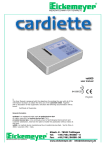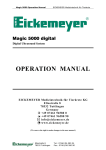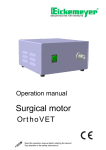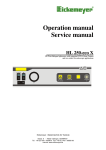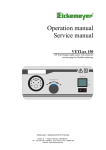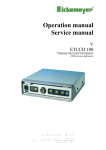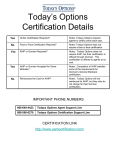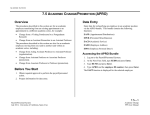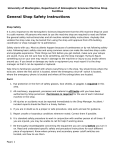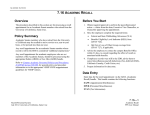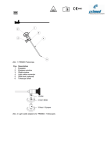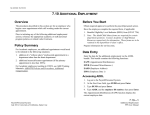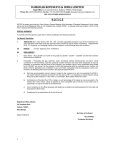Download Eickemeyer Vetrix Laser CO2 Surgical Laser System (4806723)
Transcript
MEDIZINTECHNIK FÜR TIERÄRZTE Eickemeyer Vetrix Laser CO2 SURGICAL LASER SYSTEM Operation Manual PLEASE READ THIS MANUAL CAREFULLY BEFORE USE AND KEEP IT FOR REFERENCE SPECIFICATIONS ARE SUBJECT TO CHANGE WITHOUT NOTICE Eltastr. 8 ▫ 78532 Tuttlingen Phone: ++49/7461/96580 – 55 Fax: ++49/7461/96580- 91 MEDIZINTECHNIK FÜR TIERÄRZTE www.eickemeyer.de ▫ [email protected] 1 MEDIZINTECHNIK FÜR TIERÄRZTE TABLE OF CONTENTS SUBJECT PAGE Preface 3 Chapter 1 Safety 4 Chapter 2 Introduction 7 Chapter 3 Installation 10 Chapter 4 Articulated Arm 11 Chapter 5 System Operation 12 Chapter 6 Aiming beam 14 Chapter 7 Surgical Accessories 15 Chapter 8 Indicators and Alarms 16 Chapter 9 Warnings 16 Chapter 10 Cleaning, disinfection & sterilization 17 Chapter 11 Maintenance 18 Chapter 12 Packing list 20 Chapter 13 Troubleshooting guide 21 Chapter 14 Technical Specifications 22 Chapter 15 Electrical Schematics 23 Chapter 16 Labels and positions 24 Chapter 17 Warranty 25 2 MEDIZINTECHNIK FÜR TIERÄRZTE Preface The Eickemeyer 15C surgical laser system is designed to meet international safety and performance standards, including FDA & CE. Personnel operating the unit must have a thorough understanding of the proper operation of the system. This manual has been prepared to aid medical and technical personnel to understand and operate the system. Do not operate the system before reading this manual and gaining a clear understanding of the operation of the system. If any part of this manual is not clear, please contact your Eickemeyer representative for clarification. The information provided in this manual is not intended to replace the physician training or professional training on the clinical use of CO2 lasers. Such training should include a review of published literature, seminars, laser workshops and appropriate preceptorships. Please contact your Eickemeyer representative for current information on available training. For Professional Information and Clinical Applications, also refer to Appendix B & C of this manual. This manual should always accompany the unit, and its location must be known to all personnel operating the unit. Additional copies of this manual are available at cost price from your Eickemeyer distributor. 3 MEDIZINTECHNIK FÜR TIERÄRZTE CHAPTER 1 Safety 1.1. The Eickemeyer 15C surgical laser system is designed to comply with FDA & CE regulations for surgical laser systems. To avoid accidental exposure to hazardous radiation, personnel operating the system must be thoroughly familiar with all its safety requirements and operating procedures. The areas of concern for safe CO2 laser operation are discussed below. 1.2. Burn Hazard CO2 laser radiation is invisible to the human eye and can cause third-degree burns or ignite inflammable materials, even when defocused. 1.3. Reflection and Direct Eye Exposure Hazard The system emits visible and invisible laser radiation that is hazardous to the eyes. Never stare into the CO2 laser beam or allow it to be reflected from any reflective surface - even rough metal can reflect the CO2 laser beam. As a precaution against accidental exposure to the output beam or to its reflections, all personnel must use appropriate safety eyewear. NOTE Never stare directly into the aiming beam. Also ensure that the aiming beam is not directed at anyone's eyes. Although this beam is low powered, direct exposure can be hazardous to the eyes. 1.4. Safety Eyewear All personnel in the vicinity of the laser unit must use safety eyewear and must ascertain that the eyewear provides adequate protection from the 10.6 micron wavelength radiation. This is generally provided by most quality glass or plastic safety spectacles with side guards for protection from lateral exposure. In the EU countries laser eyewear must be CE marked for 10.6 micron laser radiation. NOTE When operating in the vicinity of the patient's eyes it is advisable to cover eyes with an opaque material. 4 MEDIZINTECHNIK FÜR TIERÄRZTE 1.5. Explosion and Fire Hazard Do not operate the unit in the presence of flammable anesthetics or volatile substances such as alcohol, gasoline or solvents. Flammable drapes, surgical gowns, gauze and other ignitable materials must be kept out of the beam path. The use of nonflammable materials and instruments is advised. Flame retardant surgical drapes, gowns, etc., are recommended. A readily accessible fire extinguisher in the vicinity of the unit is also recommended. For safety it is advisable to surround the surgical area with wet towels or gauze since these will absorb any stray laser radiation. Be sure to keep them wet throughout the procedure. 1.6. High Voltage Hazard The laser unit generates high voltages within the main cabinet. To avoid injury, do not operate the unit before ensuring that all of its panels are properly closed. Do not attempt to remove or disassemble any panels. NOTE Only Vetrix authorized technical personnel may service the unit. 1.7. Using the Proper Power Receptacle and Plug • Use only the power receptacle and plug specified for your unit. • Use only a power receptacle and plug that are in good condition. NOTE To remove the power cord from the receptacle, hold it by the plug. Never pull on the power cord to remove the plug from the receptacle. 1.8. Grounding the Unit The unit is grounded through the grounding conductor in the power cord. Good grounding is essential for safe operation. To ensure grounding reliability, always plug the power cord into a properly wired power receptacle. 1.9. Compliance with The Eickemeyer 15C laser unit complies with: International • US Federal Performance Standards 21 CFR 1040.10 and 21 Standards CFR 1040.11 for Class IV laser products. • European Directive 93/42/EEC Concerning Medical Devices (Annex II). 5 MEDIZINTECHNIK FÜR TIERÄRZTE • European Directive 89/336/EEC Concerning Electromagnetic Compatibility. NOTE In accordance with these regulations, a recommended routine inspection and maintenance schedule is provided in the Maintenance chapter of this manual. 1.10. Warning, Figure 1-1 shows the location of the important labels affixed Identification and to the unit. These include: Certification Labels 1. Laser emission danger label - warning against: Possible exposure to laser radiation and specifying the types of laser present. 2. Non-interlocked warning label - warning against: a. Risk of explosion if used in the presence of flammable anesthetics. b. Possible electrical shock when cover is removed. c. Possible radiation exposure when laser enclosure is opened. 3. Electric shock warning label - warning user to properly ground the unit, against opening the unit's cover and information concerning: a. Degree and type of protection against electric shock. b. CE marking in compliance with the requirements of 93/42/EEC directive concerning medical devices (Annex II). 4. Identification label - noting unit model number, serial number, electrical requirements and date of manufacture. 5. Certification label - manufacturer and/or distributor details. 6. Laser aperture warning label - indicating laser beam exit location. 6 MEDIZINTECHNIK FÜR TIERÄRZTE CHAPTER 2 Introduction 2.1. Working Principle of the System 2.1.1. Principle of CO2 Laser Surgery The wavelength emitted by a CO2 laser is 10.6µm. This wavelength is in the far infrared and is invisible to the human eye. Water has extremely high absorption at this wavelength. A 30 micron thin layer of water will absorb 90% of CO2 laser radiation, and only 10% will pass through. Since 75-95% of soft tissue is composed of water, this wavelength is highly absorbed in soft tissue and therefore highly effective in vaporizing soft tissue, regardless of colour. Tissue vaporization is instantaneous with very minimal surrounding thermal necrosis which aids in hemostasis. To allow precise positioning of the surgical laser beam, an additional red, low power laser beam is incorporated in the system so that both beams are coincident at the surgical site. 2.1.2. System Description The Eickemeyer 15C CO2 laser system is based on a 15 Watt sealed-off CO2 laser which is microprocessor controlled for safe and easy operation. 2.1.3. Main Cabinet 1. CO2 laser and aiming beam diode laser. 2. Switching-mode power supply, high voltage constant current. 3. Main control panel. 4. Cooling system. 5. Footswitch. 6. Articulated arm. 2.1.4. CO2 laser and The sealed-off CO2 laser is situated inside the main cabinet aiming beam laser on adjustable mounting brackets. A solenoid operated beam shutter and a power detector are positioned in front of the laser tube. A low power diode aiming beam laser is positioned in front of the shutter and is reflected onto the optical axis of the CO2 laser beam via a dichroic mirror. The CO2 laser beam and the diode aiming beam are aligned to be coaxial as they both enter and travel along the articulated arm. 7 MEDIZINTECHNIK FÜR TIERÄRZTE 2.1.5. High Voltage, A switching-mode power supply is used to convert the input Constant Current line voltage to the high voltage required to produce a gas Power Supply discharge inside the laser tube. The energy from this gas discharge excites CO2 molecules to obtain population inversion which is a perquisite for laser action. 2.1.6. Main Control Panel The flat, soft-touch control panel is fully microprocessorcontrolled to allow safe and simple control and setting of all system parameters. Two displays exhibit laser power and time settings. 2.1.7. Cooling System The laser cooling system is a closed-loop system. The liquid coolant (distilled or deionized water) is circulated by a pump to remove heat generated in the laser tube. 2.1.8. Footswitch Laser emission to tissue is controlled by a footswitch. When pressing the footswitch, the shutter is opened and laser emission through the articulated arm is enabled. 2.1.9. Articulated Arm The articulated arm is a high precision laser beam delivery system consisting of a series of hollow tubes connected by rotating, mirrored joints. The articulated arm is springbalanced to allow the surgeon easy manipulation of the laser beam and full wrist motion, within a working radius of 110 cm from the main cabinet. 2.2. Location of Components 2.2.1. External Components 8 MEDIZINTECHNIK FÜR TIERÄRZTE 2.2.2. Internal Components CHAPTER 3 Installation 3.1. Unpacking and Inspection 3.2. Water Tank Coolant The unit is shipped with an empty water tank. To fill the water tank first verify that the unit is unplugged from the wall. Unscrew the 3 screws on the back of the unit and carefully lift up the top cover, starting from the back. The front of the cover is held in a slot in the base of the unit. Slide the cover out of this slot as you lift it up. Take care not to disconnect the cables connecting the base to the cover. Unscrew the cap of the water tank; fill with distilled or deionized water taking care not to spill water onto the inside of the system. Use a funnel or a plastic tube to fill the tank up to about 1cm from the top. A quantity of 1.2 ltr is required. Close and screw back the cover. 9 MEDIZINTECHNIK FÜR TIERÄRZTE WARNING Do not attempt to turn on the unit before filling the water tank. 3.3. Checking Power Voltage Insure that the input power voltage from the wall plug complies with the requirement of the instrument, as marked on the unit. 3.4. Connecting Power Cord Insert the power cord into the socket on the back of the unit and then into the wall outlet. Assure that the plug and wall socket are properly grounded. 3.5. Footswitch Connection Insert the footswitch cable into the socket located on the back of the unit. A polarizer on the receptacle prevents incorrect cable connection. Push in the alignment notch until a sound is heard indicating that the plug is locked. 3.6. Remote Interlock Connector Laser safety regulations require surgical lasers to be equipped with a remote interlock connector to which an external interlock, such as a door interlock may be connected. To operate the unit, this socket must either be connected to such a remote interlock or alternatively must be shorted by the interlock shorting plug provided with the system. 3.7. Temporary Start Insert the master key and rotate 90º clockwise to turn on the unit. Water pump and cooling fan will be heard. If not - check that the Emergency Stop Switch is released. Turn off unit. CHAPTER 4 Articulated Arm 4.1. Articulated Arm The articulated arm is shipped separately from the laser cabinet. Unpack the arm and carefully install it over the arm port on the main cabinet. Lock the side screw to secure the arm in place. The arrow on the arm's main joint should point at the direction at which the joint rotates when the arm is pulled down. Attach the focusing handpiece with the focal plane indicator tip to the end of the articulated arm. Verify that the arm rotates freely in all directions and is sufficiently balanced. 10 MEDIZINTECHNIK FÜR TIERÄRZTE 4.2. Alignment Check Turn the system on and verify that the aiming beam is emitted through the articulated arm. If necessary, press the aiming beam key to turn on the aiming beam. Remove the focusing handpiece and place a transparent piece of paper (or Scotch tape) over the opening of the articulated arm. Check that the aiming beam is approximately centered to the arm port. Repeat this check at various different positions of the arm. Attach the focusing handpiece with the focal plane indicator. Place any target (such as a wooden tongue depressor) at the tip of the focal plane indicator and check that the aiming beam is approximately centered to an imaginary tube extending from the focusing handpiece tube. After reading the instructions below, turn on the CO2 laser, set for 5 Watt, 0.1 sec pulse, fire at a moistened wooden tongue depressor (or other appropriate target) and check that the focal spots of the CO2 and aiming beam lasers coincide. For convenience, mark a cross on the tongue depressor, position the aiming beam on the cross and fire a single laser pulse. The resulting burn mark should coincide with the cross. Some displacement is allowed provided that a portion of the burn mark covers the center of the cross. NOTE Repeat this check at various positions of the articulated arm. NOTE If misalignment is noticed - contact your local representative. 11 MEDIZINTECHNIK FÜR TIERÄRZTE CHAPTER 5 System Operation 5.1. Turn-On Following the installation and articulated arm alignment check, turn-on the system by rotating the master key switch 90º clockwise. If the system does not turn on check that the Emergency Stop Switch is released. Always remove the key when unit is left unattended. 5.2. Function Selection 5.2.1. STBY State Press "STBY" key and note that indicator light turns on. In this state, pressing of the footswitch will not initiate laser emission. During a pause in operation always return unit to the STBY state to avoid inadvertent laser emission. 5.3. Emission Mode Selection 5.3.1. CONTINUOUS The CONT mode should be chosen whenever continuous laser emission is desired. In this mode laser radiation will be emitted from the articulated arm for as long as the footswitch is pressed. The display will exhibit "---" to indicate that the unit is set in the CONT mode. 5.3.2. SINGLE In the SNGL mode setting, laser radiation will be emitted as a single pulse of radiation every time the footswitch is pressed. Pulse duration will depend on the time setting and can be adjusted between 0.02-1.0 seconds. To emit an additional pulse footswitch should be pressed again. If footswitch is released before pulse duration is over, laser emission will be automatically interrupted. 5.3.3. PULSER In the PLSR mode laser pulses are repeatedly emitted for as long as the footswitch is pressed. Once footswitch is released laser emission is immediately interrupted. In the PLSR mode, laser pulse duration and pulse interval duration will depend on the time setting and can be adjusted from 0.02-1.0 sec. 12 MEDIZINTECHNIK FÜR TIERÄRZTE 5.4. Power and Time Setting 5.4.1. Power Setting Laser power output can be set from 0.5 to 15 Watts. Power is adjusted by pressing the "up" or "down" keys on the control panel. Power Setting Resolution: 5.4.2. Time Setting When the system is on CONT mode the time display will indicate "---". When the system is on SNGL or PLSR mode, the default time setting is "0.02" second. Time setting may be adjusted up to 1 second in increments of 0.01 seconds. The display will indicate time setting in seconds. 5.5. READY State After the above settings, set the function key to READY state. When the system is in the "READY" state, the laser indicator light flashes intermittently. When pressing the footswitch, laser radiation will be emitted from the articulated arm according to the mode setting on the control panel. Laser indicator illuminates continuously and the audible warning buzzer is heard. Before pressing the footswitch always make sure that the handpiece and aiming beam are directed at an appropriate target. Also bear in mind that the CO2 laser beam may penetrate and continue beyond the target. NOTE When the system is in the" READY" state, laser parameters can not be adjusted. To adjust any of the parameters system must first be set to the STBY state. 13 MEDIZINTECHNIK FÜR TIERÄRZTE CHAPTER 6 Aiming Beam 6.1. Since the CO2 surgical laser beam is invisible, a separate, low power, visible, red diode laser aiming beam is incorporated in the system. The surgical and the aiming laser beams are coaxial so that the surgical beam, when operated, will be directed at the spot where the visible diode beam is aimed. The aiming beam may be turned on or off by pressing the aiming beam key on the main control panel. NOTE European safety regulations (IEC 601-2-22) permit the aiming beam to be turned off only in situations where a mechanical pointer is available to indicate the position of the CO2 laser beam. 14 MEDIZINTECHNIK FÜR TIERÄRZTE CHAPTER 7 Laser Surgical Accessories 7.1. The Eickemeyer 15C mm handpiece set as beam focal plane is handpiece. The spot plane, is 0.4 mm. laser system is supplied with a 100 a standard accessory. The CO2 laser indicated by the straight tip on the size for the handpiece, at the focal NOTE See paragraph 10 below for handpiece cleaning and sterilization instructions. 7.2. Handpiece Standard Parts The handpiece set is comprised of the following standard parts: Handle Straight tip Backstop tip 7.3. Handpiece Optional Parts The following angled tips are optional: 90 deg. reflector tip 120 deg. Reflector tip 15 MEDIZINTECHNIK FÜR TIERÄRZTE CHAPTER 8 System Indicators & Alarms 8.1. Coolant Circulation When the power is turned on, the water pump begins to Indicator work. The coolant indicator should illuminate steadily. In case of a fault, such as low coolant level or high coolant temperature (above 40ºC), indicator light will flash and a buzzer alarm will be heard. If this occurs, turn system off, allow system sufficient time to cool down, and attempt to resume work. If same fault reoccurs, turn system off, unplug from the wall and check water in the coolant tank. Refill if necessary. CHAPTER 9 Warnings 9.1. Under no circumstances, should the laser beam be directed at an eye or healthy skin. 9.2. Laser beam should not be directed at any reflective surface, such as stainless steel or mirror surface. 9.3. If alcohol is used to clean any part of the instrument or to prepare surgical site, allow sufficient time for alcohol evaporation before turning on the laser beam. Avoid other inflammable or explosive substances in the vicinity of the laser beam. 9.4. In order to prevent contamination of the focusing lens it is recommended to always use a suitable smoke evacuation unit and, in addition, to connect the nozzle on the handpiece to a low pressure air or inert gas source. 9.5. The operator and all personnel in the room should wear appropriate laser safety eyewear whenever the laser is turned on. 9.6. The system should be stored in an area where the temperature is always within 1-50ºC and relative humidity is below 80%. 16 MEDIZINTECHNIK FÜR TIERÄRZTE CHAPTER 10 Cleaning, disinfection and sterilization NOTE Always clean / disinfect directly after use before stains dry on parts. 10.1. To clean / disinfect the handpiece, first remove the lens holder. Only the remaining metal parts may be cleaned with water or instrument detergent. These parts may be disinfected in standard disinfection solutions or may be steam autoclaved. Thoroughly rinse and dry these parts before reuse. 10.2. Handpiece lens may be cleaned with a cotton swab dipped in high grade acetone (such as Chemically Pure). The lens holder may be cleaned with a cotton ball dipped in hospital grade 70% alcohol solution. The lens holder may be cold gas sterilized but should not be autoclaved or disinfected. WARNING Never allow the lens to come into contact with water. Do not steam autoclave or disinfect the lens. 10.3. Unit itself may be cleaned / disinfected with liquids. Before cleaning unit remove the power cord from the AC outlet. To clean unit use damp cloth or cotton dipped in hospital grade 70% alcohol solution or a disinfectant liquid. Avoid excessive use of liquid and dry well before reconnecting unit to power source. 17 MEDIZINTECHNIK FÜR TIERÄRZTE CHAPTER 11 Maintenance WARNING There are high voltages in the instrument. Any maintenance should therefore be referred to Vetrix authorized service personnel. Power meter calibration check should be performed every 6 Calibration Check months. Equipment required for the calibration check is a calibrated external power meter such as Ophir model 300A, or equivalent. The procedure for the calibration check is as follows: 11.1 Power Meter 1. With the handpiece attached to the articulated arm, position the external power meter detector 2 cms beyond the focal plane of the lens. 2. Turn unit on and set power for 5 Watts continuous emission. 3. Direct the aiming beam at the center of the detector and press footswitch. Note the external power meter reading. 4. Repeat the procedure for continuous emission of 10 W and 15W. 5. If the external power reading deviates by more than 15% from the laser setting, power calibration of the laser system is required. NOTE Power meter calibration procedure must be performed only by Vetrix-authorized technical personnel. 18 MEDIZINTECHNIK FÜR TIERÄRZTE 11.2 Power Meter Calibration Check Power meter calibration procedure should be performed only by Eickemeyer authorized technical personnel, according to the following procedure: 1. With the handpiece attached to the articulated arm, position the external power meter detector 2 cms beyond the focal plane of the lens. 2. Remove the top cover as instructed in 3.2. 3. Push down the safety interlock switch (on the rear panel) indicated in fig.1 with the aid of a rubber ring or a string. 4. With the interlock key in the OFF position (no power), pull out the short-circuit plug (fig.2, item1) and plug it in the calibration position (fig. 2, item 2). 5. Switch on the power (Key Interlock ON), set power to 5 Watts, select CONT mode and then press READY mode. Press the footswitch and check actual emitted power on the external power meter display. If actual emitted power is lower (or higher) than 5 Watts, push the power up (or down) key on the unit's control panel until actual emitted power is 5 Watts. Press Diode key to save the data in the microprocessor. 6. Switch off power and return short-circuit plug back to its previous position. 7. Close top cover, operate unit, set power at 5 Watts and recheck actual emitted power on the external power meter. Repeat the procedure for a power setting of 1 and 10 Watts. At all three power settings actual power emitted should be within +/-10% of power displayed on the laser unit. 19 MEDIZINTECHNIK FÜR TIERÄRZTE 11.3 Fuse Replacement To check and / or replace the fuses on the auxiliary panel, turn off the unit and disconnect the power cord from the power receptacle. Wait 2 minutes to allow high voltages to discharge. Replace fuses only with the same type and rating of fuse. For exact fuse rating, refer to the fuse listing on the auxiliary panel. CHAPTER 12 Packing List Laser articulated arm 1 set Handpiece 1 set Power cord 1 set Foot switch 1 set Remote Connector 1 set Master key 2 sets User Manual 1 set Spare parts Fuse (3A) 20 MEDIZINTECHNIK FÜR TIERÄRZTE CHAPTER 13 Troubleshooting Guide SYMPTOMS POSSIBLE CAUSES ACTIONS power cable After main power is switched Power plug is not properly Check connections to the wall and on, the panel does not light connected. to the unit. and the water pump is not Fuse is loose or burned. heard. Verify that emergency stop Emergency Stop switch is switch is released. pressed in. Check and replace fuse if necessary. footswitch as Unit seems to run properly but Footswitch is not properly Connect instructed in the manual. there is no laser beam connected. emitted from the arm. Top cover of the unit is not Close top cover. properly closed. Check and lock any loose Articulated arm is not joint in the arm. properly connected. Laser power is emitted in the Pulse mode calibration is off Contact Vetrix authorized CONT mode but not in the (particularly for short pulse technician to perform pulse SNGL or PLSR modes settings) mode power calibration on the unit. Laser emission stops, coolant Instrument is operated too Wait for the cooling water to indicator flashes and an long and coolant is too hot. cool down and restart unit. audible alarm is on. Unit is too noisy. Table on which unit positioned is not stable. is Place unit on a stable and flat surface. 21 MEDIZINTECHNIK FÜR TIERÄRZTE CHAPTER 14 Technical Specifications Laser Type: Sealed-off CO2 laser Laser Wavelength: 10.6 microns Output Power: 0.5 - 15 Watt, adjustable Focal Spot Diameter: 0.4mm Lens Focal Distance: f = 100mm Aiming Beam: Diode laser 2mW, 650nm Delivery System: 7 joint, spring-balanced articulated arm Operation and Control: Microprocessor controlled, touch screen Emission Modes: Continuous, Single pulse, Pulser Pulse duration: 0.02 - 1.00 seconds Displays: Power, Time Cooling System: Closed loop, water Electrical Input: AC 220V ±10%, 50HZ AC 110V ± 10%, 60HZ Input Power: 200VA Ambient Temperature: 5 - 40ºC Relative Humidity: < 80% Dimensions (mm): 360 x 610 x 210 (mm) Weight (kg): 12 22 MEDIZINTECHNIK FÜR TIERÄRZTE CHAPTER 15 Electrical Schematics 23 MEDIZINTECHNIK FÜR TIERÄRZTE CHAPTER 16 Labels and positions 24 MEDIZINTECHNIK FÜR TIERÄRZTE CHAPTER 17 Warranty Eickemeyer warrants to the original purchaser or, for products purchased from an authorized reseller to the original end-user that Eickemeyer-branded products will be free from defects in materials and workmanship for a period of 18 months from the date of shipment. During the warranty period Eickemeryer will, at its option: (1) Provide replacement parts necessary to repair the product. (2) Replace the product with a comparable product. (3) Refund the amount you paid for the product, less depreciation, upon its return. Defects of the product are to be immediately indicated to Eickemeryer in writing. Eickemeryer does not accept any warranty for defects which have arisen due to natural wear, incorrect, improper or inappropriate use of the product or any conditions differing from those stipulated in the operating manual. For repairs carried out by nonEickemeryer authorized third parties, Eickemeryer shall not be held liable and does not accept any warranty. If the client fails to provide the co-operation required for the replacement delivery or rectification of defects then its claim for warranty is waived. Eickemeryer shall not be liable for consequential damage caused by defect unless Eickemeryer expressly assured the client that such a feature of the product which failed due to the defect, was to prevent the occurrence of the respective consequential damage. There are no further warranty claims. Eltastr. 8 ▫ 78532 Tuttlingen Phone: ++49/7461/96580 – 55 Fax: ++49/7461/96580- 91 MEDIZINTECHNIK FÜR TIERÄRZTE 25 www.eickemeyer.de ▫ [email protected]


























